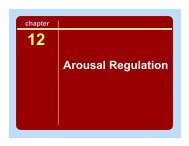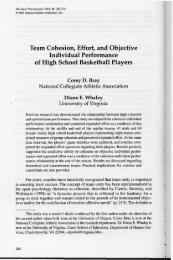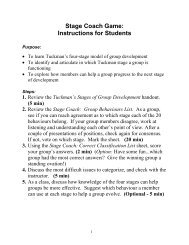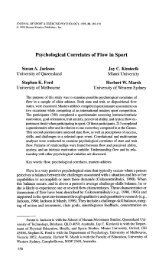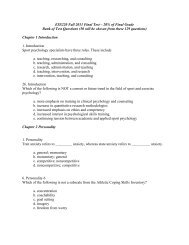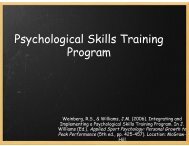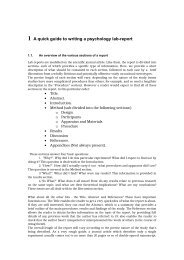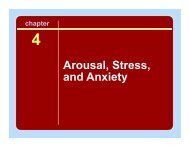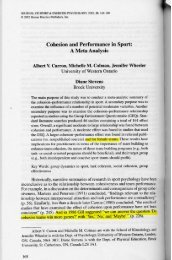Sport and Exercise Psychology Review - Sport Psychology Goes to ...
Sport and Exercise Psychology Review - Sport Psychology Goes to ...
Sport and Exercise Psychology Review - Sport Psychology Goes to ...
You also want an ePaper? Increase the reach of your titles
YUMPU automatically turns print PDFs into web optimized ePapers that Google loves.
Coping with, <strong>and</strong> reducing the number of<br />
careless shots: A case study with a county<br />
golfer<br />
Mark A. Uphill & Marc V. Jones<br />
A county level golfer reported that when his concentration wavered, the consistency of his pre-shot routine<br />
broke down <strong>and</strong> he played what he termed ‘sloppy’ (or careless) shots. After playing a careless shot, the participant<br />
would often become angry <strong>and</strong> annoyed <strong>and</strong> the associated feelings remained with him, leading <strong>to</strong><br />
errors on successive holes. A pre-shot routine comprised the basis of the intervention which was designed <strong>to</strong><br />
assist the participant cope with, <strong>and</strong> reduce, the number of careless shots. Results suggested that the intervention<br />
was effective at reducing the relative number of careless shots <strong>and</strong> enhancing specific performance<br />
attributes (e.g. motivation). Little change in the participant’s emotional state pre- <strong>to</strong> post-intervention was<br />
observed. Although further research is necessary, this case study suggests that performance routines may be<br />
used <strong>to</strong> help athletes cope adaptively with errors by refocusing attention.<br />
AT THE START of the intervention the<br />
participant was a 28-year-old male<br />
golfer with a h<strong>and</strong>icap of 1.2 who was<br />
employed full time as a marketing coordina<strong>to</strong>r.<br />
In an e-mail initiating contact with the<br />
second author 1 <strong>and</strong> follow-up interview, the<br />
participant indicated that several facets of<br />
his mental approach could be improved. He<br />
commented that when his concentration<br />
wavered, the consistency of his pre-shot routine<br />
broke down <strong>and</strong> he played careless (or<br />
what he termed ‘sloppy’) shots. After playing<br />
a careless shot, the participant would often<br />
become angry <strong>and</strong> annoyed <strong>and</strong> the associated<br />
feelings <strong>and</strong> cognitions (e.g. ‘I shouldn’t<br />
have played that shot’) remained with him,<br />
often leading <strong>to</strong> errors on successive holes.<br />
Alongside the initial interview <strong>and</strong> e-mail,<br />
data from a specifically designed ‘golf booklet’<br />
was collected over six competitions<br />
which, firstly, provided baseline data upon<br />
which <strong>to</strong> assess the efficacy of the intervention<br />
<strong>and</strong>, secondly, collectively helped formulate<br />
a cognitive behavioural intervention<br />
tailored <strong>to</strong> the requirements of the individual.<br />
The golf booklet was completed after<br />
each round of golf <strong>and</strong> comprised, for each<br />
careless shot that occurred, (a) a description of<br />
the situation preceding the careless shot (a<br />
measure of golf performance was attained by<br />
calculating the ratio of sloppy shots: holes<br />
played); (b) an assessment of pre-shot concentration<br />
on a Likert-type scale ranging<br />
from 1 ‘not at all’ <strong>to</strong> 10 ‘very much so’; (c)<br />
an assessment of the intensity of a range of<br />
emotions on a Likert-type scale ranging<br />
from 0 ‘not at all’ <strong>to</strong> 4 ‘extremely’; <strong>and</strong> (d)<br />
an evaluation of whether these emotions<br />
debilitated or facilitated selected performance<br />
attributes on a Likert-type scale ranging<br />
from -3 ‘very debilitated’ through 0<br />
‘neutral’ <strong>to</strong> 3 ‘very facilitated’. Emotions<br />
assessed in this study (anger, anxiety, disappointment,<br />
embarrassment, regret, panic)<br />
were selected in conjunction with the participant<br />
who felt that these could be experienced<br />
after playing a careless shot. The<br />
performance attributes (rhythm, motiva-<br />
1<br />
The intervention was delivered jointly by the first author (British Association of <strong>Sport</strong> & <strong>Exercise</strong><br />
Sciences (BASES) Probationary <strong>Sport</strong> Psychologist undertaking supervised experience)<br />
<strong>and</strong> the second author (British Psychological Society Chartered Psychologist & BASES Accredited<br />
<strong>Sport</strong> Psychologist).<br />
14 <strong>Sport</strong> & <strong>Exercise</strong> <strong>Psychology</strong> <strong>Review</strong> Vol 1 No 2<br />
© The British Psychological Society 2005 ● ISSN 1745–4980



